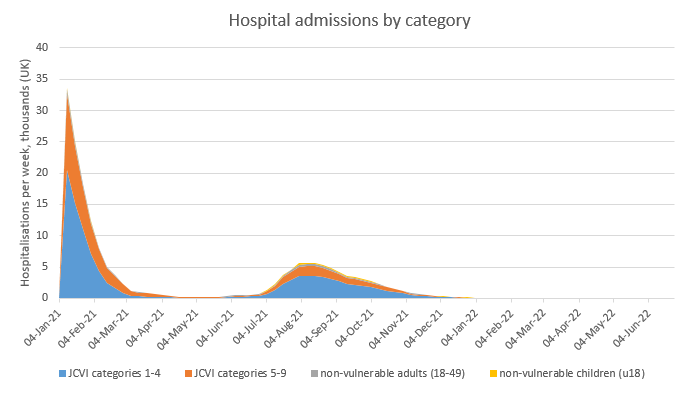
My “don’t panic” tweet from yesterday got a lot of traction – but today I’m going to recover my corona-centrist credentials by being more concerned. Again, this is mostly a story about LFDs and schools, and I’m not quite sure yet what to make of it. 1/n
https://twitter.com/JamesWard73/status/1374047771393658889?s=20
Let’s start by looking at the short-term growth rates in different age groups, so we know where to drill down. They show a clear spike in 5-9 and 10-14 year olds, and maybe a hint of upwards pressure in their parents (35-40s). Cases are falling nicely in the over-80s. 2/n 

Looking at the 5-9 year olds, we can see the spike on the 15th March which has then tailed away since – so as per my recent tweets, I’m getting less worried about this. We need to keep an eye on it, but it’s not an obvious problem right now. 3/n 

The more concerning chart is actually the 10-14 year olds, where there is a very clear spike in Sunday’s specimen data. This is an odd age group since we have a mix of primary kids (10-11) who aren’t getting LFD tested and secondary kids (12-14) who are. 5/n 

Digging a bit further into the data, I *think* (but not 100% sure yet) the main issue is in the slightly older, LFD-tested kids. Certainly there is a spike in Sunday & Monday’s LFD-recorded positive cases – but sadly we don’t have an age breakdown of this. 6/n 

Now, this also corresponds to a spike in the number of LFD tests, so perhaps we shouldn’t be too worried – it may just be the continued effect of the shift to home-testing, which is changing the weekly pattern of when tests are being taken. 7/n 

But the reason why I’m a bit more cautious today is that the positivity rate for Monday has shifted upwards – to c. 0.15% compared to 0.10% last week, or a 50% increase. That’s slightly concerning, and I’d like to see how that trend evolves. 8/n 

(incidentally, please ignore the positivity spikes on Saturdays - there are complex technical reasons why it does that, and for the purposes of this discussion, it's best ignored. there are not many schools-related LFDs done on Saturdays) 9/n
So, a trend to watch. A possible reason why positivity *might* have increased is if parents and teenagers are being more diligent in recording the positive tests than they are the negative ones (whereas we trusted schools to do both). 10/n
So, this isn’t definitely a problem, but it could turn into one. And remember: an increase in cases in children isn’t a major issue in itself, it only becomes one if it “leaks” into other age groups. And there’s not much evidence of that happening at this stage. /end
• • •
Missing some Tweet in this thread? You can try to
force a refresh














